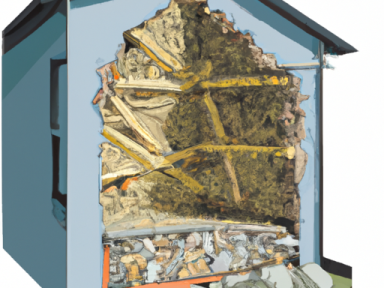Did you know that the average American home loses around 30% of its heat through poorly insulated walls and roofs? With energy costs constantly on the rise and environmental concerns becoming more pressing, it’s crucial to find effective and sustainable ways to keep our homes warm in the winter and cool in the summer.
While modern insulation materials like fiberglass and foam are widely used, they come with a range of concerns including health risks and environmental impact. But fear not, there are natural alternatives that can provide excellent insulation without compromising our well-being or the planet.
1. Straw Bales
Straw bales have been used as a building material for centuries and are highly effective for insulation. Commonly used in construction, straw bales can be stacked as walls or used as infill in timber frames. They provide great thermal performance by trapping air within the straw, creating an insulation barrier.
Keep in mind that straw bales require proper sealing and protection from moisture to prevent rotting. Additionally, they may be susceptible to pest infestations, so regular inspections and maintenance are necessary.
2. Recycled Denim
Yes, you read that right! Recycled denim, made from old jeans and clothing, is another fantastic natural insulation option. This material is safe to handle and install, making it an excellent choice for DIY enthusiasts.
Recycled denim insulation offers excellent thermal and sound insulation properties, keeping your home cozy and quiet. It is also resistant to mold and mildew, making it a healthy choice for your indoor environment. Plus, using recycled denim helps divert waste from landfills and reduce our carbon footprint.
3. Sheep’s Wool
Sheep’s wool insulation, or wool batts, is an outstanding natural option for home insulation. Not only does it provide excellent thermal insulation, but it also offers superior moisture regulation, reducing the risk of condensation and mold growth.
Sheep’s wool is a renewable and biodegradable material that is safe and easy to handle. It can be installed as batts or loose-fill and is particularly suitable for attics, walls, and floors. By choosing sheep’s wool insulation, you’re not only keeping your home comfortable but also supporting sustainable agriculture.
4. Cork
Cork, often associated with wine bottles and bulletin boards, can also be used as an insulation material. Cork insulation boards are made from the bark of cork oak trees and offer excellent thermal and acoustic properties.
These boards are easy to install and provide a long-lasting insulation solution. Additionally, cork is a sustainable material, as the bark of cork oak trees can be harvested without harming the trees, allowing them to regenerate and continue absorbing carbon dioxide from the atmosphere.
5. Hempcrete
If you’re looking for a natural insulation material that can also regulate humidity and enhance indoor air quality, consider hempcrete. Hempcrete is made from the woody core fibers of the hemp plant mixed with lime and water.
It is lightweight, breathable, and resistant to pests and fire. Hempcrete provides excellent thermal insulation, reducing energy consumption and maintaining a comfortable indoor temperature. Choosing hempcrete helps support the cultivation of hemp, an eco-friendly crop that requires minimal water and no pesticides.
As you can see, there are plenty of natural insulation alternatives to choose from. Whether you’re concerned about your health, the environment, or simply want to reduce your energy bills, these materials and techniques offer sustainable and effective solutions for keeping your home comfortable all year round.
Remember, taking action now to improve your home’s insulation not only benefits you but also contributes to a more sustainable and resilient future.




GIPHY App Key not set. Please check settings